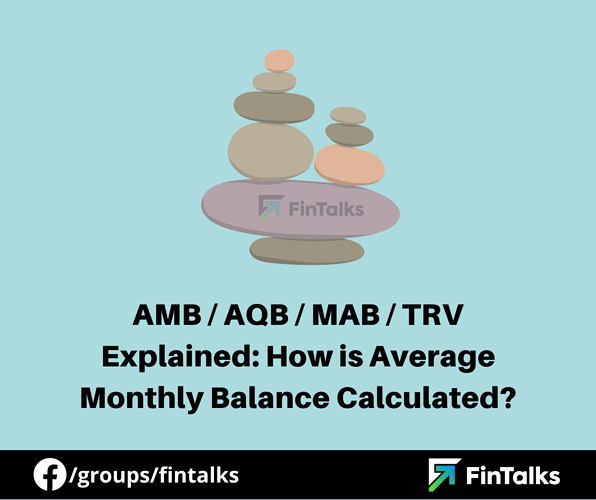Whenever you want to open a bank account, you will hear the term: AMB/AQB/MAB/TRV. It specifies the average balance you need to maintain in that bank account. How is this average balance calculated? We will know that in today’s post.
Definition of the Terms AMB / AQB / MAB / TRV:
- AMB stands for Average Monthly Balance.
- AQB stands for Average Quarterly Balance.
- MAB stands for Monthly Average Balance. It is the same as AMB.
- TRV stands for Total Relationship Value. This includes the total amount of your Account Balance, FD, RD, Mutual Funds from the same AMC, etc. (AMC stands for Asset Management Company).
How is the Average Monthly Balance Calculated in the Banks?
The Formula is this:
Average Balance over ‘X’ days = [(Balance on Day 1) + (Balance on Day 2) + (Balance on Day 3) + … + (Balance on Day X)] / X.
Let’s understand this:
- Let’s say you are required to maintain an average balance of ₹100 for a period of 3 days.
- You put ₹100 on the bank account and didn’t take out anything.
- By the above formula, your average balance will be: [100+100+100]/3 = ₹100.
- If you are required to maintain the same for 30 days, and you didn’t take out any money, then also your average balance will turn out to be ₹100 using the above formula.
How to maintain Average Balance?
Well, let’s come back again to the ₹100 for a period of 3 Days Problem:
Case 1: What happens if you take out ₹10 on Day 2?
- Let’s calculate: [100+90+90]/3 = ₹93.3.
- So your average balance will be ‘below’ the required level.
Case 2: What happens if you take out ₹10 on Day 2 and put back ₹10 on Day 3?
- Let’s Calculate: [100+90+100]/3 = ₹96.6.
- Again, your average balance will be ‘below’ the required level.
- So, merely putting back the amount that you have taken earlier, won’t be sufficient to fulfill the average balance criteria. In fact, if you add a few days gap to it, the average balance will keep falling for the number of days it was in deficit.
Case 3: Now let’s do something Clever. Take out ₹10 on Day 2 and put back ₹20 on Day 3.
- Let’s Calculate: [100+90+110]/3 = ₹100.
- Bingo! We did it. We were able to maintain the average balance this time. How did we do it?
- Let’s Understand: There was a deficit of ₹10 on Day 2, and ₹10 on Day 3 also (before funding in). Hence, we had to fund ₹20 to match it.
- This is the logic behind maintaining average balance.
Case 4: Take out ₹10 on Day 1, Put back ₹5 on Day 2, and again ₹20 on Day 3.
- Let’s Calculate: [90+95+115]/3 = ₹100.
- Bingo! We did it again. We were able to maintain the average balance this time too. How did we do it?
- Let’s Understand: There was a deficit of ₹10 on Day 1, ₹10 on Day 2 (before funding in), and ₹5 on Day 3 (before funding in). Remember the deficit amount is calculated out of ₹100.
- So, a total of ₹10+10+5 = ₹25 was the deficit. It was funded over 2 days, ₹5 on Day 2 and ₹20 on Day 3.
- What to learn from this is, that you can spread out the deficit amount over a few days to make up for it. However, due to the deficits created over days, you need to pour in more money to make up for it.
Now think about it for bigger amounts and a higher period of time like 30 days. The formula will remain the same throughout.
I hope this helps you understand the concept of Average Balance. Thank you for reading. Don’t forget to join our FinTalks Facebook Group & FinTalks Telegram Channel for regular updates on banking and finance.
